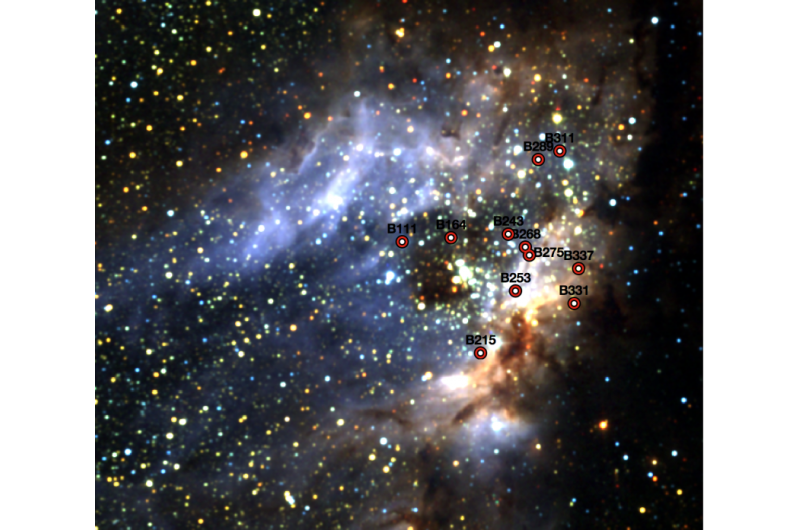No close partner for young, massive stars in Omega Nebula

Astronomers from Leuven (Belgium) and Amsterdam (Netherlands) have discovered that massive stars in the star-forming region M17 (the Omega Nebula) are—against expectations—not part of a close binary. They have started their lives alone or with a distant partner star. The researchers base their findings on data from the X-shooter spectrograph on ESO's Very Large Telescope in northern Chile. The study will be published in Astronomy & Astrophysics Letters.
The Omega Nebula is an open cluster in the constellation Sagittarius. The cluster is at a distance of about 5,000 light years and contains some dozens of young, hot stars. Hugues Sana (University of Leuven), Maria Ramirez-Tannus, Lex Kaper and Alex de Koter (University of Amsterdam) discovered that these massive stars have surprisingly little differences in their radial velocity, the speed towards us or away from us. If these stars were binaries their radial velocity would likely differ by tens to hundreds of kilometers per second because they are in their orbits around each other. In M17 it ranges with only five kilometers per second.
Most stars are not alone. Recent research shows that 70 percent of the massive stars (some 10 to 100 times the mass of the Sun), which end their lives as neutron star or black hole, has one or more near companions.
As a contrast, a statistical analysis shows that only about 10 percent of the massive stars in M17 are narrow binaries. Alternatively, M17 may contain a lot of wide binaries, compared with older star forming regions harboring both narrow and wide binaries.
This is the first time that such a young star-forming region is examined for the presence of binary stars. The reason is that such areas are hidden from view by the gas and dust from which the new stars are formed. It is therefore a challenge to get spectra of high quality, from which the radial velocity can be determined.
First author Sana: "If M17 has indeed no narrow binaries, these systems have to appear later in evolution. Maybe they are only wide binaries, which later migrate towards each other. Co-author Ramirez-Tannus is enthusiastic about the results: "We have now observed ten of them and will study many more to understand how wide binaries change in narrow binary stars."
The answer to the question whether massive stars usually live together in binaries is important for understanding of the star formation process. However, it is also an indication for the formation of the number of neutron binaries and double black holes, which eventually can produce a gravitational wave.
More information: A dearth of short-period massive binaries in the young massive star forming region M17: Evidence for a large orbital separation at birth?
Provided by Netherlands Research School for Astronomy



















